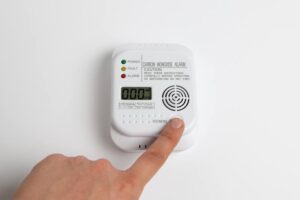Carbon monoxide is a toxic, odorless gas produced when fuel burns incompletely. It can stem from everyday household appliances, such as furnaces, water heaters, gas stoves, and fireplaces. Improper ventilation, poorly maintained equipment, or faulty installations can allow CO to accumulate in your home. Why is this a concern? Well, breathing in carbon monoxide can cause symptoms like dizziness, headache, nausea, confusion, and, in severe cases, unconsciousness or death. Long-term exposure, even at low levels, can lead to chronic health problems, especially for young children, the elderly, and individuals with respiratory issues.
This is why having properly installed and well-maintained carbon monoxide detectors in your home is not just recommended — it’s essential, particularly during the winter months.
The Importance of Regular Carbon Monoxide Detector Checks
Winter brings a higher risk of carbon monoxide exposure because most households rely heavily on heating systems. If your furnace, fireplace, or space heater isn’t functioning correctly, it could release CO into your home. That’s why regularly checking your carbon monoxide detectors is critical.
Ensuring Functionality
CO detectors have a limited lifespan, typically 5 to 10 years. Over time, their sensors can degrade, making them less reliable. Regular checks ensure the devices are functioning correctly when you need them most.
Preventing False Security
A detector that’s present but non-functional can give a false sense of security. Without regular testing, you may assume your home is protected when, in reality, the device might not work in an emergency, leaving you and your loved ones vulnerable to carbon monoxide poisoning.
Adapting to Winter Conditions
During winter, snow and ice can block ventilation pipes and flues, increasing the likelihood of CO buildup. Regular checks of your detectors ensure they’ll alert you to rising CO levels, giving you time to act.
How to Check Carbon Monoxide Detectors
Knowing how to check your carbon monoxide detector is key to keeping your home safe. Follow these simple steps:
- Perform a Test: Press the “Test” button on the device to ensure the alarm sounds. Most detectors emit a loud beep or chirp during testing. If the alarm doesn’t sound, replace the batteries or the unit itself if it’s outdated.
- Check the Expiration Date: Carbon monoxide detectors often have a sticker or stamp indicating their manufacturing or expiration date. If your detector is past its prime, replace it immediately.
- Clean the Unit: Dust and debris can accumulate on carbon monoxide alarms, impacting their performance. Use a soft cloth or vacuum with a brush attachment to clean the device gently.
Make a habit of testing your CO detectors monthly and replacing batteries at least once a year. Simplify the process by doing it while you prepare your heating system for the holiday season.
Additional Winter Carbon Monoxide Safety Tips
Beyond checking your carbon monoxide detectors, there are several other steps you can take to protect your family from CO poisoning:
Keep Your Furnace Maintained
Professional furnace maintenance ensures your heating system operates safely and efficiently. A technician can inspect for potential issues like cracked heat exchangers, which are a common source of CO leaks.
Keep Vents Clear
Regularly check that outdoor vents, chimneys, and flues are free of snow, ice, and debris. Blocked vents can trap carbon monoxide inside your home.
Avoid Indoor Combustion
Never use outdoor appliances such as grills or portable generators inside your home or garage. These devices are not designed for indoor use and can produce dangerous amounts of CO.
Use Space Heaters Wisely
If you use a space heater, choose one that is certified for indoor use and has built-in safety features. Always follow the manufacturer’s instructions for safe operation.
Install CO Alarms Throughout Your Home
Stay ahead of any potential problems by investing in the right amount of CO detectors. Place one of these devices on each level of your home and in each bedroom for maximum protection.
Contact H.J. Faust for Your Winter Heating Needs
Do you remember the last time your furnace received a professional tune-up? A well-maintained heating system not only ensures your home stays warm but also reduces the risk of carbon monoxide leaks. For example, neglecting maintenance could lead to clogged burners, faulty pilot lights, or cracked components, all of which increase CO risks.
At H.J. Faust, we offer furnace maintenance services to keep your heating system in peak condition. Since 1978, we’ve been helping Burlington, WI, homeowners prepare their furnaces for the winter season with expert care. In this way, we help prevent carbon monoxide issues, as well as enhance energy efficiency, lower utility bills, and extend the life of your equipment.
Don’t wait for a CO emergency — schedule a furnace tune-up today and enjoy peace of mind all winter long.



